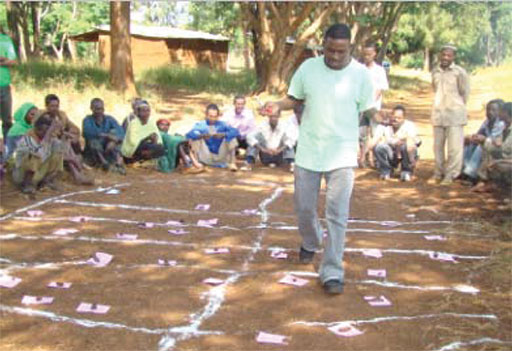10.3.1 Community-led total sanitation (CLTS)
Community-led total sanitation (CLTS) was mentioned in Study Session 9. It is a method for mobilising communities to completely eliminate open defecation by triggering collective behaviour change (UNICEF, 2008). In Ethiopia the name has been modified and you are more likely to come across ‘CLTSH’, which stands for community-led total sanitation and hygiene.
CLTS/CLTSH depends on raising awareness that everyone in the community is at risk of exposure to disease even if only a few people continue to defecate in the open. It has been successful in ensuring that all households gain access to safe sanitation facilities in many parts of Ethiopia. It helps communities to understand the negative effects of poor sanitation and empowers them to collectively find solutions to their sanitation situation. CLTSH is about bringing sustainable behavioural change. In general, it works best in villages that have enthusiastic leadership but it is also dependent on convincing everyone to change their behaviour. Besides leadership, many other local social, physical and institutional conditions affect the prospects for CLTSH.
CLTSH involves trained facilitators working with communities as they go through three phases of the process: pre-triggering, triggering and post-triggering phases (Kar and Chambers, 2008).
CLTSH pre-triggering phase
The facilitators must visit the selected kebele or kebeles prior to the community triggering. This visit is mainly to estimate the size of the community and its population but also to identify the dirtiest areas in the vicinity that are most frequently used for open defecation. This must be done with the community, possibly using a participatory mapping process, as shown in Figure 10.10. They also decide on the most appropriate season and place to conduct the community triggering.
CLTSH triggering phase
Community triggering happens at a gathering of the local inhabitants who come together to have a dialogue about concerns related to open defecation. The purpose of this dialogue is to bring collective action against the open defecation behaviour. Triggering refers to the moment when the whole community shares a sense of disgust and shame about open defecation. The facilitator helps them to come to the realisation that they quite literally will be eating one another’s shit if open defecation continues.
In particular, the aim of the triggering phase is to reach agreement about actions to be taken. The actions will be governed by bylaws developed by the community. The final output of triggering is a community-based action plan, which includes an agreed schedule and set of activities that everyone in the community commits to participating in. This involves construction of latrines with handwashing facilities and commitment from everyone that they will use the new facilities at all times.
CLTSH post-triggering phase
After the community-based action plan is prepared, the community members must put the plan into action. They develop bylaws to ensure the elimination of the practice of open defecation in their community. The plan also states who will implement and enforce the bylaw.
In this phase, participatory review meetings should be organised by community members and facilitated by Health Extension Workers or other CLTSH-trained facilitators. The main purpose of these sessions is to review the progress made towards achieving the objectives of the plan. A sanitation map prepared during triggering can be used again to follow the progress made (Figure 10.10). Households that have constructed and started using a latrine are marked on the sanitation map. Comparing this with the original map can show the progress made in the reduction of open defecation sites.

10.3 Interventions to promote improved hygiene and sanitation
